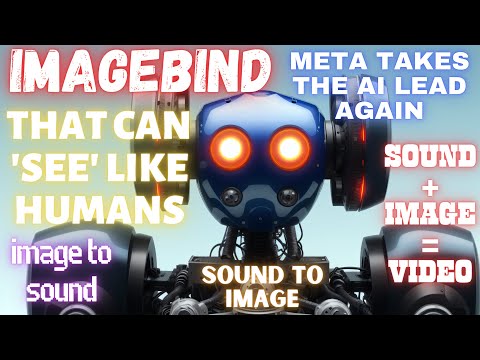Our Discord server ⤵️
https://bit.ly/SECoursesDiscord
If I have been of assistance to you and you would like to show your support for my work, please consider becoming a patron on 🥰 ⤵️
https://www.patreon.com/SECourses
Technology & Science: News, Tips, Tutorials, Tricks, Best Applications, Guides, Reviews ⤵️
Playlist of StableDiffusion Tutorials, Automatic1111 and Google Colab Guides, DreamBooth, Textual Inversion / Embedding, LoRA, AI Upscaling, Pix2Pix, Img2Img ⤵️
Official link ⤵️
https://ai.facebook.com/blog/imagebind-six-modalities-binding-ai/
GitHub link ⤵️
https://github.com/facebookresearch/ImageBind
Interactive Demo link ⤵️
https://imagebind.metademolab.com/demo?modality=I2A
Research paper PDF link ⤵️
https://dl.fbaipublicfiles.com/imagebind/imagebind_final.pdf
0:00 Introducing to new groundbreaking ImageBind
0:14 What is ImageBind?
0:52 Interactive demo of ImageBind
2:46 Official demo video of Meta ImageBind
3:30 Official research paper supplementary video of ImageBind
#science #imagebind #meta
The research paper presents IMAGEBIND, a novel approach that learns a joint embedding from six different modalities – images, text, audio, depth, thermal, and Inertial Measurement Unit (IMU) data. The primary innovation of IMAGEBIND is its ability to create this joint embedding using only image-paired data, leveraging the ‘binding’ property of images. This approach effectively extends the zero-shot capabilities of large-scale vision-language models to other modalities by merely using their natural pairing with images.
The introduction of the paper underscores the idea that a single image can bind together a multitude of sensory experiences. However, acquiring all types and combinations of paired data with the same set of images is challenging. Previous methods have attempted to learn image features aligned with text, audio, and other modalities, but these final embeddings have been limited to the pairs of modalities used for training, and therefore, cannot be utilized universally. IMAGEBIND overcomes this problem by aligning each modality’s embedding to image embeddings, leading to an emergent alignment across all modalities.
IMAGEBIND uses web-scale (image, text) paired data and combines it with naturally occurring paired data such as (video, audio), (image, depth), etc., to learn a single joint embedding space. This setup enables the alignment of text embeddings with other modalities such as audio and depth, thus enabling zero-shot recognition capabilities without explicit semantic or textual pairing. The paper further explains that IMAGEBIND can be initialized with large-scale vision-language models like CLIP, which offers the advantage of using the rich image and text representations of these models. This makes IMAGEBIND highly versatile, applicable to a variety of different modalities and tasks with minimal training.
The authors demonstrate the effectiveness of IMAGEBIND by using large-scale image-text paired data along with naturally paired ‘self-supervised’ data across four new modalities – audio, depth, thermal, and IMU readings. They report strong emergent zero-shot classification and retrieval performance on tasks for each of these modalities, with improvements as the underlying image representation is made stronger. On audio classification and retrieval benchmarks, IMAGEBIND’s emergent zero-shot classification matches or even outperforms specialist models trained with direct audio-text supervision on benchmarks like ESC, Clotho, AudioCaps.
Additionally, IMAGEBIND’s representations also outperform specialist supervised models on few-shot evaluation benchmarks. The paper concludes by demonstrating the wide range of applications for IMAGEBIND’s joint embeddings. These include cross-modal retrieval, combining embeddings via arithmetic, detecting audio sources in images, and generating images given audio input. Thus, IMAGEBIND sets a new standard in emergent zero-shot recognition tasks across modalities, and it also provides a new way to evaluate vision models for visual and non-visual tasks.




